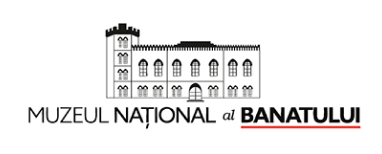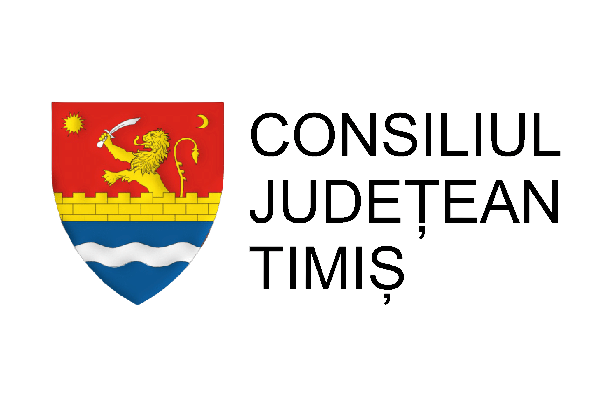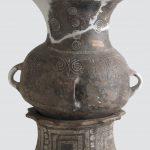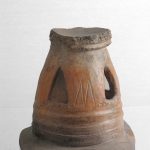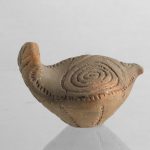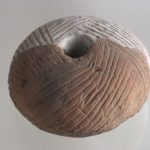-

Spadă de tip viking din sec. al X-lea

Spadă de cavaler de o mână şi jumătate (cumpăna sec. XIII-XIV).
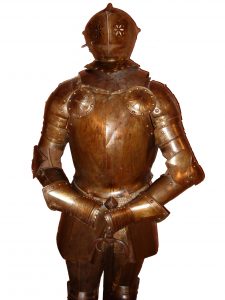
Armură de la cumpăna sec. XV-XVI (copie din sec. XIX).

Buzdugan din sec. al XVI-lea
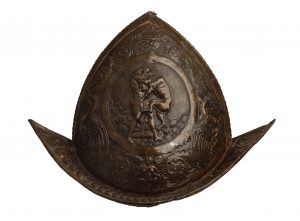
Coif italian de tipul Morion (sec. al XVI-lea).

Spadă de călău, de tip german, din sec. al XVII-lea.

Cuţit de vânătoare de tipul Hirschfänger (sec. al XVIII-lea).
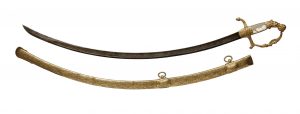
Sabia generalului austriac Johann von Hiller (1754-1819).

Sabia familiei nobiliare Osztoics (sec. al XIX-lea).
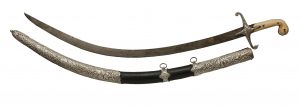
Sabie turcească de tipul shamshir (sec. al XIX-lea).

Iataganul liderului mişcării antiotomane sârbeşti Đorđe Petrović „Karađorđe“ (datat în anul 1812).

Armă mixtă („Axe-pistol”) din sec. al XIX-lea.

Puşcă balcanică de tipul džeferdar (sec. XVIII-XIX).

Puşcă de tir sportiv din prima jumătate a sec. al XIX-lea.

Pistol balcanic cu cremene de tipul Elbasan (prima jumătate a sec. al XIX-lea).

Pistol balcanic cu cremene de tipul Foča (mijlocul sec. al XIX-lea).

Pistol cu percuţie din colecţia subprefectului Muzslay László (sec. al XIX-lea).
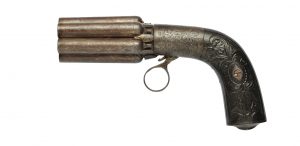
„Piperniţă” de tipul Mariette, donaţia juristului Gozsdu Elek (mijlocul sec. al XIX-lea).
Începuturile colecţiei de armament din cadrul Muzeului Banatului din Timişoara sunt strâns legate de primii ani de existenţă ai Societăţii de Istorie şi Arheologie din Timişoara, societate înfiinţată în anul 1872 la iniţiativa elitei cultural-ştiinţifice bănăţene.
Colecţia istorică de arme a muzeului timişorean cuprinde astăzi câteva sute de piese, cea mai mare parte a obiectelor provenind din vechea colecţie a muzeului (perioada 1872-1914), unde au ajuns în urma unor donaţii, achiziţii, descoperiri arheologice sau în urma schimbului de obiecte, practică existentă în primii ani ai Societăţii.
Colecţia de arme albe, mai numeroasă şi spectaculoasă decât cea a armelor de foc, se încadrează cronologic între sec. al X-lea şi anii celui de-al Doilea Război Mondial, cuprinzând întreaga gamă de arme: militare, civile, de paradă, pentru vânătoare, scrimă etc.
Colecţia armelor de foc acoperă temporal perioada de timp cuprinsă între sec. al XVI-lea şi Primul Război Mondial. Armele de foc din patrimoniul Muzeului Banatului sunt de mai multe tipuri: militare, civile, de vânătoare, pentru tir etc.
Referitor la spaţiul de origine al armelor din colecţie, marea majoritate a pieselor militare sunt de factură central-europeană. O categorie aparte o reprezintă piesele balcanice şi turceşti, destul de numeroase, reprezentate în mod special de iatagane. Mare parte din armele balcanice reprezintă capturi de război din timpul campaniei militare austriece din Bosnia din vara anului 1878.
Săbiile de paradă sunt de provenienţă maghiară şi austriacă, iar armele de vânătoare sunt în proporţie covârşitoare de factură austriacă. Printre piesele exotice amintim existenţa unui însemnat număr de arme asiatice şi africane.
În ceea ce priveşte clasificarea armelor de foc în funcţie de mecanismul de dare a focului, marea lor majoritate sunt arme cu cremene, urmate de cele cu percuţie (capsă) şi într-o mai mică măsură de armele cu percuţie centrală.
Dintre piesele deosebit de valoroase ale colecţiei amintim: sabia de călău a oraşului Timişoara, o spadă medievală de tip viking, iataganul care i-a aparţinut liderului mişcării antiotomane sârbeşti Đorđe Petrović „Karađorđe“, sabia generalului austriac Johann Freiherr von Hiller, sabia familiei nobiliare Osztoics, un coif italian de tipul Morion din sec. al XVI-lea, o archebuză datată în sec. XVI-XVII, o puşcă-tromblon din sec. XVIII, o armă cu aer comprimat de tipul Girandoni de la cumpăna sec. XVIII-XIX, o puşcă balcanică de tipul džeferdar din sec. XVIII-XIX, puşti de vânătoare realizate în atelierul vienez „Fruwirth” (începutul sec. al XIX-lea), „piperniţe” de tipul Mariette etc.
Colecţia armelor de foc cuprinde şi două tunuri: unul mobil, de asalt, realizat la Reşiţa şi utilizat în timpul Revoluţiei de la 1848-1849 şi unul fix, austriac, de crenel, amplasat iniţial pe una din porţile cetăţii Timişoara.
Cele mai reprezentative piese ale colecţiei de armament au fost publicate în cadrul a două cataloage de specialitate: Zoran Markov, Dragutin Petrović, Cold Arms, Vršac, 2012 şi Zoran Marcov, Sergiu Galiş, Pistoale şi revolvere – Colecţia de arme a Muzeului Banatului Timişoara, Timişoara, 2014.
-
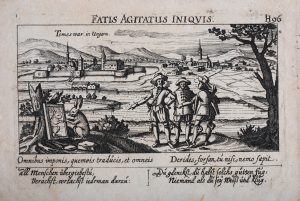
Paulus Furst (17th century), Timişoara, wood engraving; the work appeared in the Cosmic Sociography by Daniel Meissner, Nuremberg, 1638
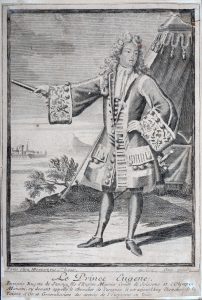
Jean Baptiste Bonnard (1686-1755), Youth Portrait of Eugene of Savoy, needle engraving
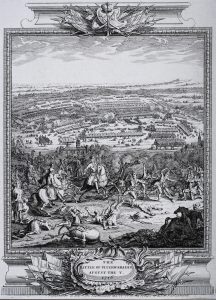
C. Benoist (18th century), Battle of Petrovaradin 1716, chisel and needle engraving
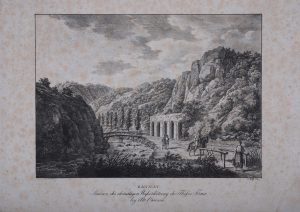
F. Wolf, Danube - The ruins of Orşova Veche, sheet from L. Erminy's notebook, Danube Course…, lithograph, sec. XIX
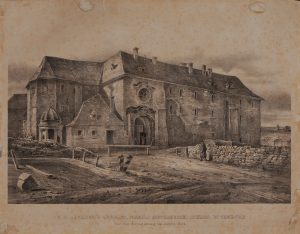
Anonymous, Huniade Castle, Timişoara, sec. XIX (before 1848), lithograph
The History collection is one of the most important collections of the Banat Museum, its beginnings being closely related to the establishment of the History and Archeology Society from Timişoara, in the 70's of the century. in the 19th century. The most valuable pieces of the collection were recorded in the period 1872-1918, but the acquisitions and especially the donations continued in the interwar years, because at the end of the '50s of the century. XX the entire patrimony of the institution to be reinvented, the historical pieces being merged with the archeological pieces.
During 2006, following the administrative reorganization of the Banat Museum, the common heritage of the former History Section was divided into two large collections, History and Archeology, the first comprising at the time of separation a documentary and museum fund of over 25,000 objects. During the same year, the History collection was enriched with numerous clichés on glass, the objects being transferred from the Ethnography Section of the Banat Museum, thus constituting a new sub-collection within the inventory.
Currently, the History collection within the Timişoara Museum counts almost 30,000 patrimony objects, which reflect the political-administrative and socio-economic evolution of the city of Timişoara and Banat during the last centuries. The pieces included in the History collection are broken down into multiple sub-collections: Armament; Historical documents; Old book; Flags and flags; Sealing matrix; Photographs and illustrations; Prints and lithographs; The painting; Clichés on glass; Decorative Art; Maps and plans; Posters etc. Of these, the most valuable can be considered the sub-collections of Armament, Flags and Flags, Old Book and Historical Documents.
Two sub-collections are worth mentioning: the cartographic one, with over 1,400 maps and plans of the city of Timişoara and of the Banat localities, and the sub-collection of posters, perhaps the largest collection of this kind in the country.
The sub-collection of decorative art, although smaller in number, includes objects from the 15th century. XVIIl-XIX, especially from Banat. Due to their stylistic diversity, the pieces reflect the tastes and the local cultural horizon, having a great documentary value.
The sub-collection of engravings represents an important iconographic testimony of Timişoara sec. XVI-XIX. Here we find: the engravings representing the battles of Zenta (from 1673) and Petrovaradin (from 1716), with reference to the anti-Ottoman wars, which marked the end of the century. 17th century - beginning of the century the eighteenth; the album dedicated to the course of the Danube with drawings by Ludwig Erminy, made by lithographs Ernest Kunike and F. Wolf, published in Vienna in 1826, but also the landscapes - called "Road on the Danube" - made after the drawings of Jacob Alt and Ludwig Erminy.
Among the most important heritage pieces of the History collection we mention: the old register of the inhabitants of Timişoara “Catastrum Civium” (the first volume of the work, which includes the period 1717-1832); Imperial Diploma for the elevation of Timisoara to the rank of Caesar-Christian City (awarded in 1781 by the Austrian Emperor Joseph II); diplomas confirming the statutes of the Timişoara guilds (from the first half of the 19th century); medieval swords from the sec. X-XIV; the sword of the Austrian general Johann von Hiller, Austrian commander who fought against Napoleon I; the wig and fez of General Bem József, commander of the Hungarian revolutionary armies during the 1848-1849 Revolution in Transylvania; The iron tree of Timişoara, symbol of the city since 1828; the emblem of the Timişoara inn "La Trompetistul"; letters of the poet George Coşbuc; the flag from Darniţa of the first battalion of Transylvanian, Banat and Bucovina volunteers, who enlisted in the Romanian army in the summer of 1917; paintings by the well-known Banat artist Stefan Jäger; the wooden crate in which the documents of the Paris Peace Conference on Romania were brought into the country; the documentary funds Ioachim Miloia and Nicolae Ilieşiu; the original document of the Timişoara Proclamation of March 12, 1990, etc. the documentary funds Ioachim Miloia and Nicolae Ilieşiu; the original document of the Timişoara Proclamation of March 12, 1990, etc. the documentary funds Ioachim Miloia and Nicolae Ilieşiu; the original document of the Timişoara Proclamation of March 12, 1990, etc.
In recent years, the History collection has been enriched with valuable objects, especially from the historical archive of the museum, but also from acquisitions or donations. We mention a document by Bogdan Voievod regarding Bucovina, antique furniture, a tree trunk brought to Timişoara as a testimony of war in the years 1916-1917 on the Italian front, etc.
The establishment of the Society of History and Archeology in Banat in 1872 marks the beginnings of the Banat Museum. Among the then aims of the Society we record the research of the historical past, the establishment of a museum of history and archeology and the initiation of some archeological excavations.
The first museum objects come from donations, accidental archeological discoveries and acquisitions. It is worth mentioning the great antiquity donation from 1873 of General Anton Scudier consisting of several Roman and feudal epigraphic and sculptural monuments, coming from Titel (today Yugoslavia). Roman monuments were also brought from Banat (Caransebeș, Orșova, etc.). Over time, valuable collections have entered the museum's patrimony, through donations or acquisitions: Ormós, Pongracz, Cesnola, etc.
In 1877, the museum officially opened to the public. The number of archeological pieces increases every year; this process took on a larger scale with the onset of systematic archaeological excavations (1893), reaching over 17,000 objects in 1916. The revival of archeological research took place only after the Second World War, especially in the 1960s, through the excavations undertaken by the specialists of the Banat Museum. We mention the researches from Tibiscum, Cruceni, Bobda, Hodoni, Parța, Remetea Mare, Foeni. Thus, the number of archeological objects has increased rapidly, reaching now over 350,000, including pieces from the Paleolithic to the modern era, coming mainly from sites on the territory of Banat. In recent years, The research topics of the archeologists of the history section focus mainly on major issues of the Neolithic, the Bronze Age, the Iron Age and the Roman Age, the Migration Age and the Early Medieval Age. Some of the museum objects in the collections are presented in the following permanent exhibitions (hosted in 19 rooms of the museum):
- Paleolithic and Epipalaeolithic
- Neolithic, Neolithic Sanctuary from Part
- The Bronze Age
- Iron Age (Northern Thracians and Geto-Dacians)
- Daco-Roman era (Roman Dacia, Daco-Roman)
- Pre-feudal and medieval period
- The modern and contemporary era
The Neolithic settlement of Parta is located in the western part of Romania, about 15 km. south of Timisoara (Timis county). In its center, a large cult building was researched.
The sanctuary is rectangular in shape, 11.6 m long and 6 m wide and is divided into two rooms: room A located to the east and room B, located on the west side of the sanctuary. In its center, on both sides of the dividing wall between the two rooms, was an altar table on which were discovered a series of objects that give us an idea of the riruals that were practiced here.
Room A houses the monumental statue on a clay pedestal decorated at the ends with meandering motifs. At the ends of the plinth are shaped two offering trays. The statue is double and depicts two characters, one female with a raised belly and another with a realistically shaped bull's head. On the altar table was a portable hearth and next to the dividing wall was a large clay cup. The altar table in this room was later divided by a two-part wall. On this wall were shaped the heads of small amines: sheep, goats. In front of the monumental statue was a door guarded by two clay columns that were finished with a bull's head. On the forehead and muzzle, the heads were decorated with incised strips and painted red and yellow. Next to this door was a second opening, probably a service entrance. which had at its top a niche in which a life-size, perforated longitudinal perforated idol-bust was discovered, in which a skull was fixed. In the corner of the room were discovered several very sharp flint blades that were used for ritual writing. During this ceremony, the blood from the slaughter of the animals was deposited in the cup on the altar table. These sacrifices were aimed at maintaining the goodwill of the divinity and originated in the idea of the primary sacrifice, the primary murder. During this ceremony, the blood from the slaughter of the animals was deposited in the cup on the altar table. These sacrifices were aimed at maintaining the goodwill of the divinity and originated in the idea of the primary sacrifice, the primary murder. During this ceremony, the blood from the slaughter of the animals was deposited in the cup on the altar table. These sacrifices were aimed at maintaining the goodwill of the divinity and originated in the idea of the primary sacrifice, the primary murder.
Room B, with the same dimensions as the previous one, was divided into two boxes of close dimensions. In the first of the boxes was a clay pedestal next to a portable hearth supported by a stake. Next to it was discovered a large amount of ashes as well as remains from the offerings to the gods. On the pedestal was an idol-bust which was decorated on the chest with zig-zag incisions and had a vertical perforation in which an animal skull was fixed. In the other box were several vessels in which offerings were placed. In one of these vessels, an amphora with a human face, phalanges from the hand of a man were discovered. Also in this space were discovered charred wheat grains that come from the offerings brought to the gods, through the ritual burning (fumigatio) of the grains.
The outer wall, to the left of the entrance, had a circular hole that cut a clay disc, and under it, glued to the wall, was a clay cup under which stood a pedestal with a stone grinder. This complex is related to the cultivated mill that was meant, by destroying the material coating of the seed, to release the regenerating, germinating forces immobilized in the grain of wheat. Also, the presence of the grinder next to the ensemble composed of the hole in the wall and the adjacent clay disk, which symbolizes the sun and the moon, links this ritual to the sun-moon cult, to the astronomical cycles of the seasons. Careful study of this ensemble in the Parthian sanctuary has shown that only one day of the year, on the date of the spring equinox, the sunlight penetrated room A of the sanctuary and stood on the bull's head of the monumental statue. This fact demonstrates that, in addition to its special cultic role, the sanctuary also played the role of a calendar that marked the beginning of spring, the season of nature's regeneration.
This cult complex functioned until the time of the IIC phase of the Banat Culture (end of the sixth millennium BC), when the 6th level of the settlement was completely and systematically destroyed in circumstances that could be related to the appearance of phase bearers in the area. C of the Vinca culture.
-
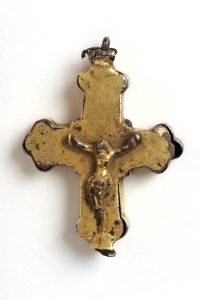
Cross-reliquary, gilded silver, sec. XIV; the Banatski Despotovac hoard (Serbia).
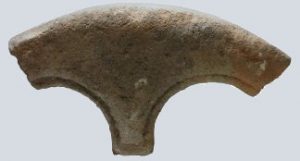
Romanesque frame, stone, sec. XIV; Timisoara-Cetate
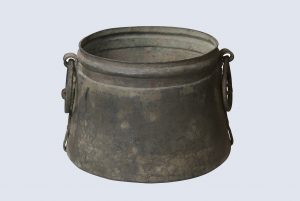
Janissary boiler, bronze, sec. XVII
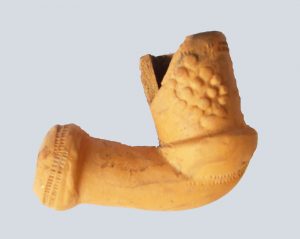
Pipe, pottery, sec. XVII; discovered at Huniade Castle, Timişoara
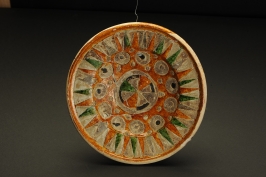
Plate, glazed pottery, sec. XVII; discovered at Huniade Castle, Timişoara
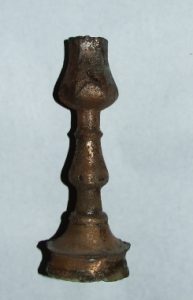
Candlestick, bronze, sec. XVII; discovered at Huniade Castle, Timisoara

Mace, iron, bone-plated wooden tail, sec. XVII

Book cover, copper, sec. XV-XVI; discovered at Huniade Castle, Timişoara
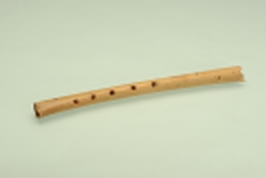
Whistle, bone, sec. XIV-XV; discovered at Huniade Castle, Timisoara

Jug, pottery, sec. XIV-XV; discovered at Huniade Castle, Timisoara
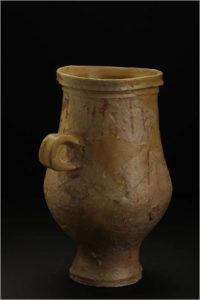
Painted cup, ceramic, sec. XIV; discovered at Huniade Castle, Timişoara
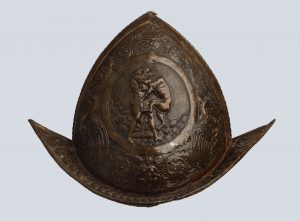
Parade helmet, iron, sec. XVI-XVII
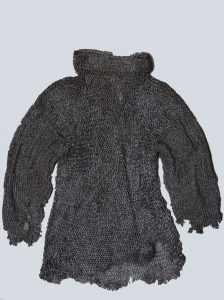
Chain shirt, iron, sec. XIV

Sword, iron, first half of the century XV.

Sword, iron, end of sec. XIII-first half of the century XIV
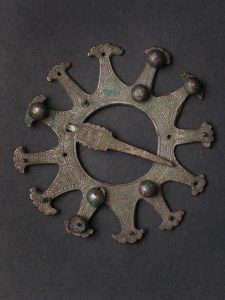
Buckle, silver, sec. XIV
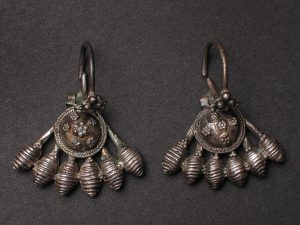
Earrings, silver, sec. XVI

Earring, silver, sec. XIV; Pongrácz Collection
The collection of objects dating back to the Middle Ages is very diverse and includes ornaments of precious metal and bronze, weapons and military equipment, ceramic and metal tableware, tiles, metalworking tools, wood, leather or bone, tools agricultural.
Like many other items of special value in our museum's collection, some of them come from donations and purchases made especially before the First World War. We mention here the 14th-century hoard of silver ornaments and pottery from Banatski Despotovac (Serbian Banat), discovered in the 19th century, which was partially included in the collection of our museum in 1881. The hoard of Banatski Despotovac belongs to the horizon of treasures XIII-XIV from the south-eastern part of Central Europe and contains pieces of a special beauty, some being products of Byzantine handicraft art, others of Western origin, among which a reliquary gilded silver cross specific to Gothic minor art.
From the collection of medieval ornaments, made mainly of silver, in the technique of filigree and granulation, we can mention tiaras, hairpins, earrings, bracelets, buckles, tassels. Many of the ornaments come from the Pongrácz collection, made up in the last decades of the 19th century by the former commander of the port of Orşova, Imre Pongrácz. Other jewelry comes from collections that belonged to other collectors who sold or donated them to our museum or from archeological excavations.
Weapons are an important component of the collection of objects from the Middle Ages. The collection of weapons includes pieces of equipment of knights from the 13th-16th centuries: knightly swords (13th century-mid-14th century), a chain shirt (14th century), helmets (14th-15th century), maces (16th century). XV-XVI), spurs, harness parts. A special piece of the medieval weapons collection is a parade helmet, decorated with mythological scenes and stylized floral ornaments, dating from the sixteenth to early seventeenth century, the product of an Italian workshop.
The collection of objects dating to the Middle Ages has been enriched due to archaeological research carried out in medieval fortresses, fairs and villages in Banat: Timişoara, Făget, Jdioara, Cenad, Satchinez, Gătaia, Hodoni, Ciclova Română. Thus, the archeological excavations carried out at the Huniade Castle in Timişoara revealed, among others, an important batch of ceramic pottery from the 14th-15th centuries, book covers (15th-16th centuries), musical instruments made of bone (14th-16th centuries). XV), tiles, arrowheads, halberd tips, cannonballs.
An important part of the collection of the Banat Museum is the objects dated to the time of the pashalac of Timişoara (1566-1716): weapons, ornaments, ceramic tableware, copper vessels, tiles, pipes, metalworking tools, tannery and leather tools, everyday wooden objects. It is worth mentioning here that due to the archaeological excavations carried out in recent years in the historic center of Timisoara, our museum has the most important collection in our country of leather objects, dating from the XVI-XVII centuries: soles and faces of shoes, pieces of clothing.
The Ottoman weapons of the seventeenth century are represented by maces, masterfully crafted, reached in our collection by purchase. One of them is part of the Pongrácz collection.
Ottoman pottery is diverse, especially glazed: cups, jugs, teapots, plates, bowls, pots, lids. We mention here the glazed ceramic plate, discovered during the recent archeological excavations at Huniade Castle in Timişoara. There were also many objects used to serve coffee and tea: bowls, cups made of Chinese or Persian porcelain, fine ceramics of Persian origin or produced in famous workshops of the Ottoman Empire, and teapots and kettles made of ceramic or metal.
The collection of household items from the Ottoman era also consists of objects used for lighting: candlesticks, candlesticks, as well as various tools and utensils: knives, spoons, thimbles. The pipe collection has been considerably enriched as a result of recent archeological excavations, of a special beauty being the Ottoman pipes, usually glazed, very beautifully decorated with vegetal or geometric motifs.
The Banat Museum also has a collection of metal vessels: cauldrons, kettles, teapots. A more special piece is a bronze janissary boiler, dating from the 17th century.
The medieval lapidary includes architectural fragments, sculpted, from the 15th century. XI-XII, which decorated one of the oldest churches in the south of the Pannonian Plain, the one in Titel (Serbia), brought to Timişoara by Baron Antal de Scudier. These are among the first pieces that laid the foundations of the collections of the Banat Museum, being donated in 1873. We also mention here the architectural fragments that come from the Cistercian monastery from Igriş (XII-XIII centuries).
Archaeological excavations carried out in the last three decades have brought to light architectural fragments from the Huniade Castle in Timişoara (14th-15th centuries), as well as a fragment of a Romanesque frame (14th century), discovered during archaeological excavations in the Cetate district of Timisoara.
The collection of stone artifacts was recently completed by the discovery of Ottoman tombstones, which are in addition to the funerary and votive sculptures that our museum has owned since before the First World War.
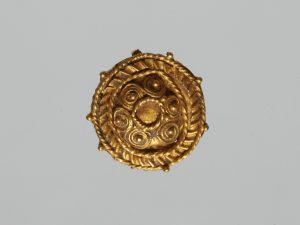
Gold appliqué from the Pongrácz collection
The Roman period collection includes pieces relevant to the provincial Roman civilization in this area of Europe. Especially at the beginning of the museum, various collectors donated or donated Roman artifacts for purchase. Thus, the Pongrácz collection includes ornaments, brooches, vessels, etc. gathered mainly from the Danube area (Clisură). The best represented, however, is the period of existence of the province of Dacia, when the Roman military and settlers established camps and settlements in the eastern part of Banat. The most important Roman site in Banat remains Tibiscum (Jupa, Caraş-Severin County), a strong military center in connection with which a city that reaches the rank of municipium is developing. Most of the Roman objects in the collection come from the systematic archeological research here (started in 1964).
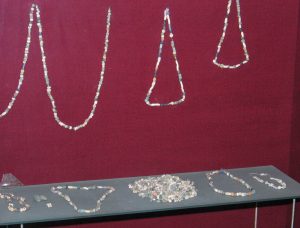
Glass beads from the glassworks, Tibiscum
The Roman army is thus present with: pieces of armament, military equipment, tiles or bricks (some stamped with the logo of the military unit), epigraphic monuments, tools, etc. Large amounts of pottery were produced and used in the civil camps or settlements, from the archeological excavations coming many ceramic objects that were restored: amphorae, pots, jugs, bowls, lampshades, etc. Some of the vessels were produced in prestigious centers in other parts of the empire; It is worth mentioning here the luxury pottery called terra sigillata, well represented in our museum. However, the craftsmen from Roman Dacia provided most of the inventory necessary for the life of the inhabitants, a situation that emerges from the inventory of archeological goods, where we find pieces of iron, bronze, glass, etc., with specialized workshops. It is interesting the glassworks workshop (archaeological research) from Tibiscum, focused primarily on the production of glass beads, these being highly appreciated by the population of the Banat plain. Most likely, the Banat Museum has the largest collection of glass beads in the territory of the former Dacia province.
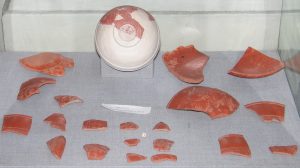
Fragments of vase terra sigillata of the Tibiscum
Roman artifacts or monuments have been discovered, through systematic or fortuitous research, in other sites of Banat: Berzovia, Orsova, Pojejena, Mehadia, Sânnicolau Mare or Cenad. Other exhibits in the museum come from very rich Roman sites in the vicinity of Banat: Colonia Dacica Sarmizegetusa and Drobeta.
The Banat plain, although not colonized by the Romans, has provided valuable archeological pieces especially through recent research. We can mention: the inventory of a Sarmatian princely tomb (1st century AD), with gold ornaments, discovered at Sânnicolau Mare; buckles and silver sconces (2nd-3rd century AD) discovered at Foeni.
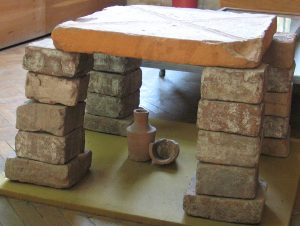
Roman bricks from Tibiscum
The lapidary of the Banat Museum
In 1873, the Society of History and Archeology of Timisoara was offered by General Anton Scudier several Roman and medieval monuments from Titel (a town on the right bank of the Tisza, today in Serbia). This important donation, which contained 16 epigraphic and sculptural pieces from Lower Pannonia, represents the beginnings of the Timişoara lapidary. Over time, it has been considerably enriched by a large number of monuments in the province of Dacia, almost all of them being brought from the Roman sites of Banat. It is worth mentioning the efforts of the archaeologist Marius Moga, who initiated systematic research in Tibiscum (Jupa, Caraş-Severin County) in 1964, the site where most of the pieces in the lapidary come from. To these are added inscriptions or other stone monuments discovered at Pojejena, Mehadia, Orşova, Slatina-Timiş, Sânnicolau Mare or Cenad. Also, three very important inscriptions for the history of the province of Dacia come from the Dacian Colony Sarmizegetusa.
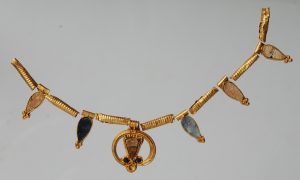
Gold necklace from a Sarmatian tomb from Sânnicolau Mare
Discover Lapidarium 3D
The Roman monuments - honorary, votive, funerary - were exhibited in the hall on the ground floor of the museum building (Huniade Castle). For museum reasons, several niches have been arranged in the walls of the corridor in which small epigraphic material is presented - fragments of inscriptions and stamped Roman bricks. A few medieval architectural fragments complete the picture of the collection of stone monuments of the Banat Museum.
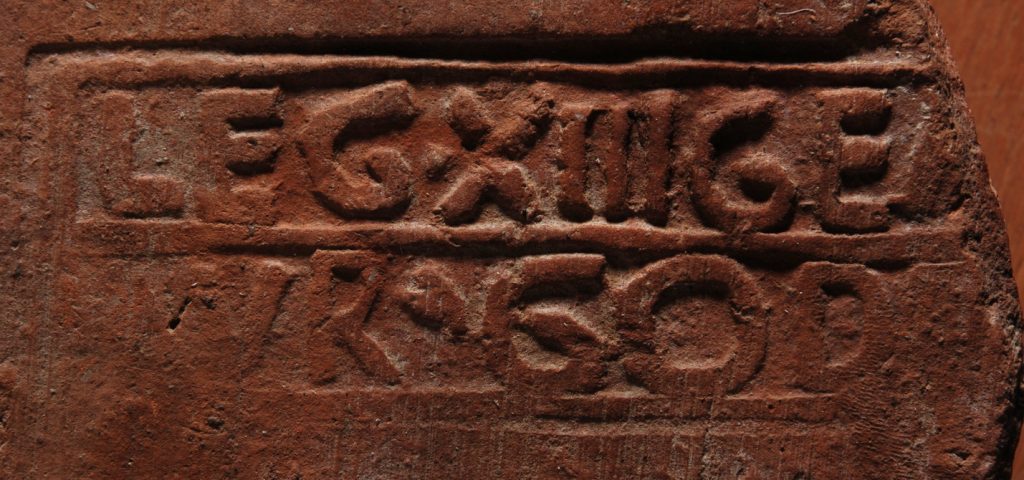
XIII Gemina (Cenad) Legion Brick Stamp
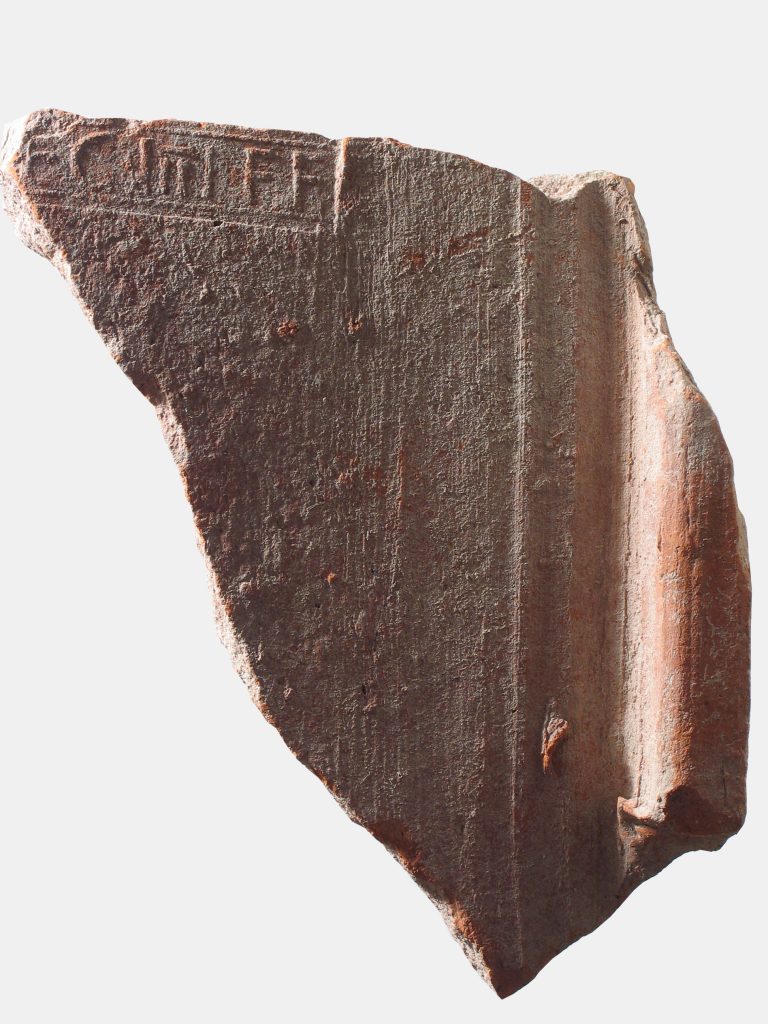
Tile with the stamp of the legion IIII Flavia Felix, Berzovia
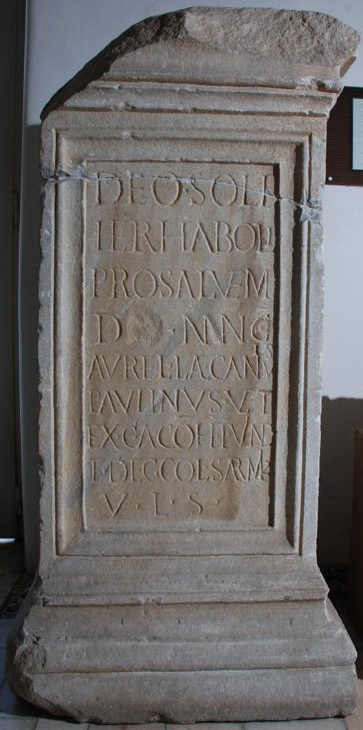
Capitoline magnifying glass on a monument in Lower Pannonia (Titel).

Monument with votive inscription from Tibiscum
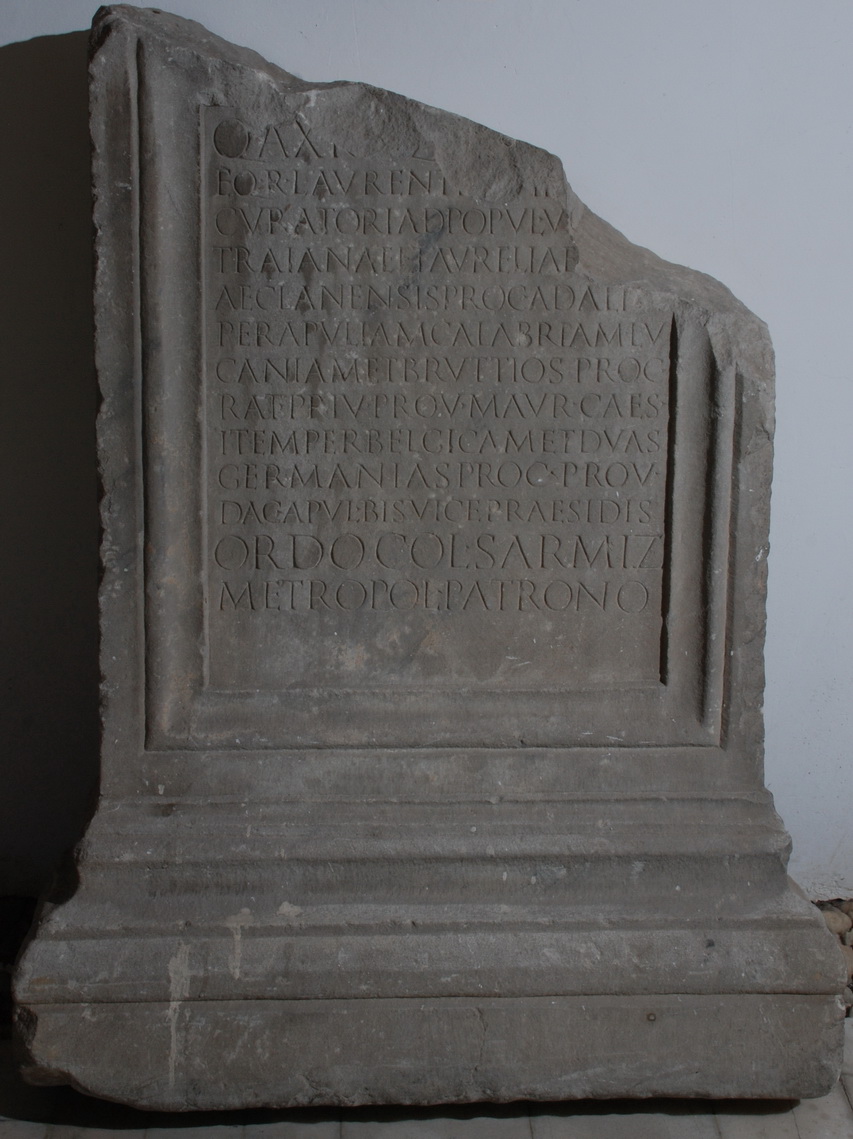
Honorary inscription of a statue, from the Dacian Colony Sarmizegetusa
-

Bracelet with zoomorphic heads, bronze, sec. X; discovered in the necropolis from Timişoara-Cioreni
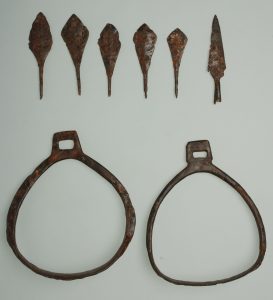
Arrowheads and saddle ladders, iron, sec. X; discovered in the necropolis from Timişoara-Cioreni
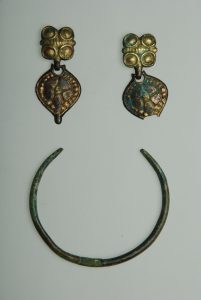
Wall lamp with pendant, gilt bronze; bracelet, bronze, sec. X; discovered in the necropolis from Timişoara-Cioreni.
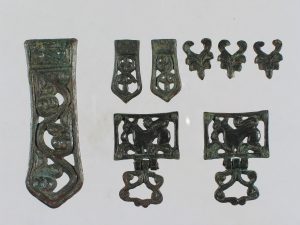
Belt pieces, bronze, sec. VIII; discovered at Sânandrei (Timiş County).
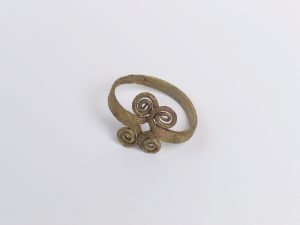
Ring decorated with facing volutes, bronze, second third of the century. V; discovered in the Timişoara-Freidorf necropolis
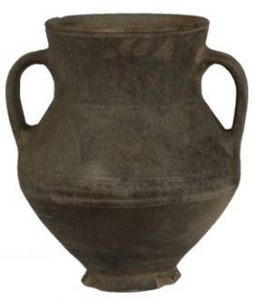
Amphoroidal vessel, modeled on the fast wheel, ceramic, sec. IV-V; discovered in Lenauheim (Timiş County).
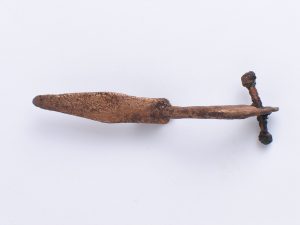
Fibula with onion-shaped buttons and rhomboid plate on the foot, bronze, second third of the century. V; discovered in the necropolis of Timişoara-Freidorf.
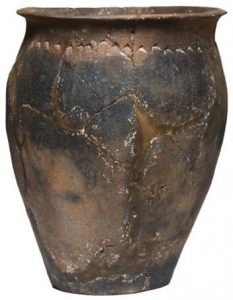
Slow-wheeled pot, ceramic, sec. IV-V; discovered in the settlement of Timişoara-Freidorf
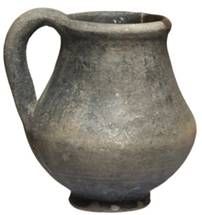
Fast wheel molded cup, ceramic, sec. IV-V; discovered in the settlement of Timişoara-Freidorf
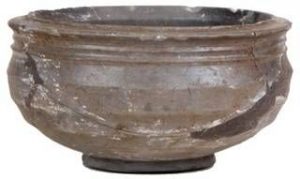
Bowl shaped fast wheel, ceramic, sec. IV-V; discovered in the settlement of Timişoara-Freidorf
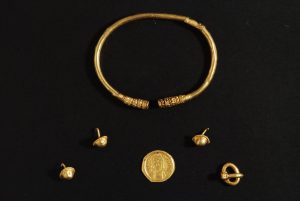
Bracelet, buckle, sconce, coin from Justinian I (527-565), gold, sec. VI; discovered in Gyula (Hungary).
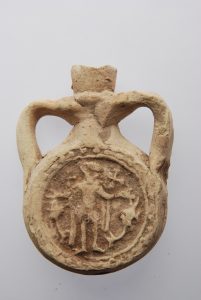
Pilgrim's box decorated with the representation of St. Mina, clay, sec. VI.
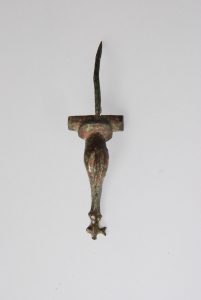
Dolphin-shaped brooch with a cross in the tail, bronze, sec. IV; discovered at Tibiscum
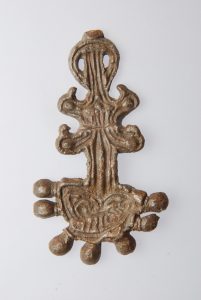
Pattern for casting digitized brooches, potin, sec. ARE YOU COMING; Pongrácz Collection
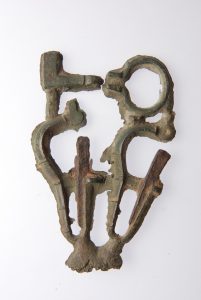
Rejected pieces, bronze, sec. VI; Pongrácz Collection
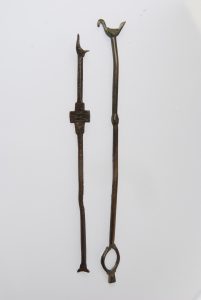
Spinning forks with Christian symbols, bronze, sec. IV-VI; Pongrácz Collection

Sword, iron, second half of the ninth century-early tenth century; discovered in Kuvin (Serbia), from the Viking environment
Coming from private collections, which arrived at the Banat Museum by donation or purchase in the 19th and 20th centuries, or from archaeological research carried out especially in the last decades, the objects dating back to late antiquity and the early Middle Ages are a significant part of the museum's heritage. our. They illustrate not only the history of Banat, but also that of the neighboring regions.
Significant in this respect is the Pongrácz collection, purchased in 1903, which belonged to the former commander of the port of Orsova, Imre Pongrácz, and which includes objects found in the Danube Gorge region and in northern Serbia. Late antiquity is represented by various pieces of clothing and ornaments, as well as by several Paleo-Christian objects - torsion forks (IV-VI centuries), patterns for casting crosses (VI century). The collection also includes other Christian objects, crosses and engolpions dating from the tenth century. Also interesting are the discarded pieces (brooches, buckles, belt accessories, keys), made of bronze, from a workshop that operated in the Roman-Byzantine fortress of Drobeta during the sixth century,
The collection of our museum also includes Paleo-Christian objects discovered in the archeological excavations carried out at Tibiscum (Jupa, Caraş-Severin County), Dierna (Orşova), or found by chance on the territory of Banat. These include lampshades (4th century), brooches (one of which is dolphin-shaped) (4th century), pilgrim plaques decorated with the representation of St. Mina (6th century), as well as a copper vessel with a cross on it. bottom, discovered at Periam (Timiş County) (6th century).
In 1903, our museum's collection was enriched by the purchase of gold pieces - buckle, bracelet, sconces and a coin (solidus) from Emperor Justinian I (527-565) - from a Gepid princely tomb (6th century). discovered in Gyula (Hungary) and bought from a jeweler who lived in that locality.
It was acquired by the collection of the Banat Museum, the collections of Nagy, Klein, Schiffmann, Fuchs, so named after the collectors who collected them, including objects dating back to the early Middle Ages, discovered in the western part of Banat. We mention here loop rings, beads, brooches, sconces, bracelets, weapons, ceramic vessels.
The collection of our museum is perpetually enriched by the archeological excavations carried out in early medieval settlements and necropolises in Banat. They brought to light a series of objects that illustrate the way of life of those who lived in the Banat lands at that time: communities of farmers and shepherds (Romanesque and allogeneic), as well as warriors of some power structures of the barbarian nations: Sarmatians, gepizi, avari, bulgari, unguri.
Thus, an important batch of ceramic tableware (cups, bowls, cups, jugs, bowls and glasses, pots, strainers, lids) was discovered in the settlement of Timişoara-Freidorf (III-V century). Along with the whole vessels (bowls, bowls, amphoroidal vessel) discovered at Lenauheim (Timiş County), dating to the 15th century. IV-V, and other vessels of various types, discovered in isolation on the territory of Banat, they make up an important collection of ceramic vessels dating to the post-Roman period and the beginning of the early medieval era.
The objects discovered in the Timişoara-Freidorf necropolis date from the second third of the 5th century: ornaments, garments, utensils, ceramic vessels. Some of the ornaments are rarities not only in the archeological landscape of Banat: the fibula with onion-shaped buttons and a rhomboidal plate at the foot or a bronze ring decorated with facing volutes.
Of significant scientific value are also the objects of wear, ornaments, weapons and vessels that date back to the Avar era (VI-VIII centuries) and the period of crystallization of the structures of medieval society (IX-X / XI centuries). We mention here the weapons, the belt and harness found in Orţişoara (Timiş County), Sânnicolau Mare, Sânandrei (Timiş County), Timişoara-Modoş Bridge, in graves that belonged to the Avar warriors (VII-VIII centuries).
The ceramic vessels, the tools, the patterns, the crucibles, the mills discovered in the settlements from Remetea Mare or Dumbrăviţa illustrate the agro-pastoral occupations and the practice of crafts in the Banat plain in the IX-X centuries. Ornaments, weapons, harnesses or household items were also found in tombs from this period. Thus, in Timişoara-Cioreni, a necropolis from the 15th century was researched. X-XI, in which ornaments and pieces of armament and military equipment were discovered, some of which were quite rare: appliqués with a pendant that decorated the caftan, a ring with a satin decorated with an eagle, a bracelet with zoomorphic heads. Also from the 10th century comes a more special piece of armament discovered in the necropolis from Voiteni (Timiş County): a bone arch, which appears quite rarely in the discoveries in Romania and in the Carpathian basin.
In our collection there are also some swords dating back to the early Middle Ages. We mention here the sword discovered at Comloşu Mare, which dates back to around 400 AD, the sword found at Timişoara-Modoş Bridge (8th century), as well as the sword from Kuvin (Serbia), dating to the second half of the century. ninth-early tenth century, from the Viking or Varangian environment.
The collection of objects dating back to late antiquity and early medieval times includes not only objects from archaeological excavations, but also archaeological complexes brought to the museum in situ: a pottery kiln discovered in the settlement of Timişoara-Freidorf (3rd century- IV), unique in Romania, as well as a pottery kiln discovered at Remetea Mare (Timiş County), dated in the 10th century.
The establishment of the Society of History and Archeology in Banat in 1872 marks the beginnings of the Banat Museum. Among the then aims of the Society we record the research of the historical past, the establishment of a museum of history and archeology and the initiation of some archeological excavations.
The first museum objects come from donations, accidental archeological discoveries and acquisitions. It is worth mentioning the great antiquity donation from 1873 of General Anton Scudier consisting of several Roman and feudal epigraphic and sculptural monuments, coming from Titel (today Yugoslavia). Roman monuments were also brought from Banat (Caransebeș, Orșova, etc.). Over time, valuable collections have entered the museum's patrimony, through donations or acquisitions: Ormós, Pongracz, Cesnola, etc.
In 1877, the museum officially opened to the public. The number of archeological pieces increases every year; this process took on a larger scale with the onset of systematic archaeological excavations (1893), reaching over 17,000 objects in 1916. The revival of archeological research took place only after the Second World War, especially in the 1960s, through the excavations undertaken by the specialists of the Banat Museum. We mention the researches from Tibiscum, Cruceni, Bobda, Hodoni, Parța, Remetea Mare, Foeni. Thus, the number of archeological objects has increased rapidly, reaching now over 350,000, including pieces from the Paleolithic to the modern era, coming mainly from sites on the territory of Banat. In recent years, The research topics of the archeologists of the history section focus mainly on major issues of the Neolithic, the Bronze Age, the Iron Age and the Roman Age, the Migration Age and the Early Medieval Age. Some of the museum objects in the collections are presented in the following permanent exhibitions (hosted in 19 rooms of the museum):
- Paleolithic and Epipalaeolithic
- Neolithic, Neolithic Sanctuary from Part
- The Bronze Age
- Iron Age (Northern Thracians and Geto-Dacians)
- Daco-Roman era (Roman Dacia, Daco-Roman)
- Pre-feudal and medieval period
- The modern and contemporary era
The Neolithic settlement of Parta is located in the western part of Romania, about 15 km. south of Timisoara (Timis county). In its center, a large cult building was researched.
The sanctuary is rectangular in shape, 11.6 m long and 6 m wide and is divided into two rooms: room A located to the east and room B, located on the west side of the sanctuary. In its center, on both sides of the dividing wall between the two rooms, was an altar table on which were discovered a series of objects that give us an idea of the riruals that were practiced here.
Room A houses the monumental statue on a clay pedestal decorated at the ends with meandering motifs. At the ends of the plinth are shaped two offering trays. The statue is double and depicts two characters, one female with a raised belly and another with a realistically shaped bull's head. On the altar table was a portable hearth and next to the dividing wall was a large clay cup. The altar table in this room was later divided by a two-part wall. On this wall were shaped the heads of small amines: sheep, goats. In front of the monumental statue was a door guarded by two clay columns that were finished with a bull's head. On the forehead and muzzle, the heads were decorated with incised strips and painted red and yellow. Next to this door was a second opening, probably a service entrance. which had at its top a niche in which a life-size, perforated longitudinal perforated idol-bust was discovered, in which a skull was fixed. In the corner of the room were discovered several very sharp flint blades that were used for ritual writing. During this ceremony, the blood from the slaughter of the animals was deposited in the cup on the altar table. These sacrifices were aimed at maintaining the goodwill of the divinity and originated in the idea of the primary sacrifice, the primary murder. During this ceremony, the blood from the slaughter of the animals was deposited in the cup on the altar table. These sacrifices were aimed at maintaining the goodwill of the divinity and originated in the idea of the primary sacrifice, the primary murder. During this ceremony, the blood from the slaughter of the animals was deposited in the cup on the altar table. These sacrifices were aimed at maintaining the goodwill of the divinity and originated with the idea of the primary sacrifice, the primary murder.
Room B, with the same dimensions as the previous one, was divided into two boxes of close dimensions. In the first of the boxes was a clay pedestal next to a portable hearth supported by a stake. Next to it was discovered a large amount of ashes as well as remains from the offerings to the gods. On the pedestal was an idol-bust which was decorated on the chest with zig-zag incisions and had a vertical perforation in which an animal skull was fixed. In the other box were several vessels in which offerings were placed. In one of these vessels, an amphora with a human face, phalanges from the hand of a man were discovered. Also in this space were discovered charred wheat grains that come from the offerings brought to the gods, through the ritual burning (fumigatio) of the grains.
The outer wall, to the left of the entrance, had a circular hole that cut a clay disc, and under it, glued to the wall, was a clay cup under which stood a pedestal with a stone grinder. This complex is related to the cultivated mill that was meant, by destroying the material coating of the seed, to release the regenerating, germinating forces immobilized in the grain of wheat. Also, the presence of the grinder next to the ensemble composed of the hole in the wall and the adjacent clay disk, which symbolizes the sun and the moon, links this ritual to the sun-moon cult, to the astronomical cycles of the seasons. Careful study of this ensemble in the Parthian sanctuary has shown that only one day of the year, on the date of the spring equinox, the sunlight penetrated room A of the sanctuary and stood on the bull's head of the monumental statue. This fact demonstrates that, in addition to its special cultic role, the sanctuary also played the role of a calendar that marked the beginning of spring, the season of nature's regeneration.
This cult complex functioned until the time of the IIC phase of the Banat Culture (end of the sixth millennium BC), when the 6th level of the settlement was completely and systematically destroyed in circumstances that could be related to the appearance of phase bearers in the area. C of the Vinca culture.
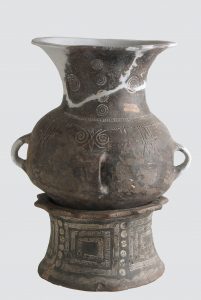
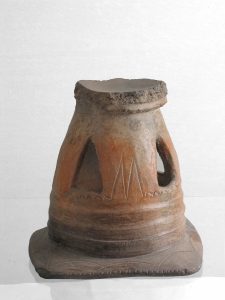
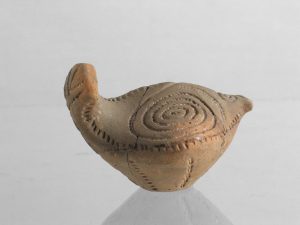
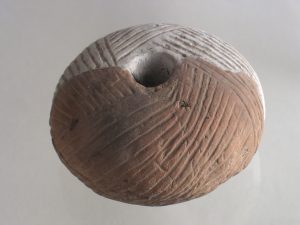
Popa'S Museum
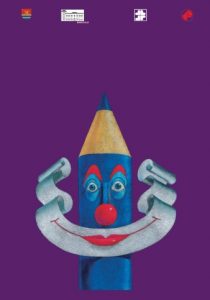
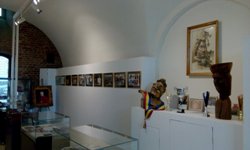
Ştefan Popa Popa 'S is an important representative of contemporary art.
For his great talent, precision and speed of work, he has won numerous national and international awards.
In 1995, ŞtefanPopa - Popa's made 131 caricatures in an hour, breaking the speed record that existed at that time, being approved by the Book of Records. Thus, he became the fastest cartoonist in the world.
In the same year, he set the world record for endurance, making 2,772 color cartoons in ten days and ten nights.
More than 200 heads of state and government have signed portraits, Popa'S.
The Popa'S Museum is part of the Visual Arts Department, of the National Museum of Banat and is located in the Theresia Bastion (in the courtyard of the bastion).
Cartoons, photographs, letters, documents and important distinctions can be seen in the museum.
Responsible for projects and actions carried out in the Popa'S Museum, is Cecilia Pătrău- Specialized Inspector, Arts-Visual Department.
HISTORY OF SATIRICAL VISUAL ART IN ROMANIA
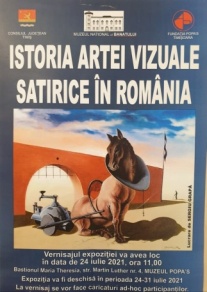
PRESS CARICATION IN ROMANIA
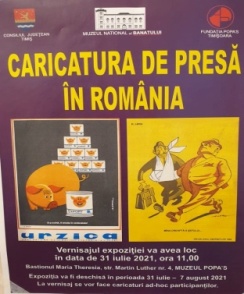
SATIRICAL VISUAL ARTS IN THE WORLD
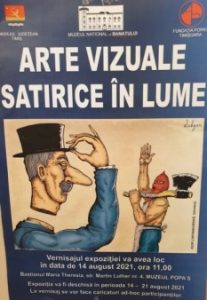
INTERNATIONAL CARNIVAL OF PRESS CARTOON AND SATIRICAL VISUAL ARTS
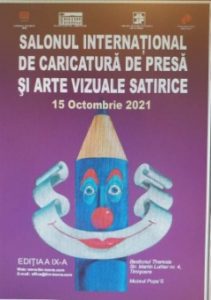
Address: Bastion Theresia
Str. Martin Luther no. 4
Open: Tuesday-Sunday 10-18
Monday closed
